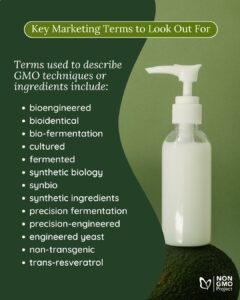Question: What do animal-free dairy proteins, vegan collagen and the blood-like compound found in some plant-based burgers have in common?
Answer: They're all ingredients featured in our new GMO awareness campaigns during the past year — and they all come from GMOs!
If you've been following along with us, you probably know that new GMOs are entering the supply chain at an alarming rate. New GMOs (sometimes called "GMO 2.0") are created using emerging techniques such as gene editing and synthetic biology. They can appear as crops with unique traits, genetically modified animals, novel compounds brewed in vats in warehouses — and much more.
New GMOs threaten the natural products industry and the movement toward regenerative agriculture in part because they are often marketed as "natural" or given dubious sustainability claims. For us folks at the Non-GMO Project, new GMOs inspire an eerie sense of déja vu. Nearly 30 years ago, traditional GMOs entered the market with some of the same promises.
Clearly, this is not our first rodeo — and experience is a powerful tool. Today's new GMOs are emerging when the Non-GMO Project is established as North America's most trusted certification for GMO avoidance. With expert researchers on staff and allies across the natural products industry, we're well-positioned to shine a spotlight on the potential downsides of new GMOs.
And that is excellent news because there isn't a moment to waste.
The decade that changed the food system
When the first GMO seeds were planted on U.S. farmland in the late 1990s, no one knew what the impacts would be. In the following decades, GMOs would cause a spike in pesticide use and contribute to the rise of superweeds and superbugs. Powerful corporate interests drove the spread of genetically modified corn, cotton and soy without long-term, independent safety studies.
By the time the Non-GMO Project was established in 2007 — ten years after the first genetically modified seeds were planted — GMOs had a firm foothold in the market. GMO corn had grown from 10% of the U.S. supply in 1996 to 73% in 2007. GMO soy went from 7.4% to 91% during the same time.
Traditional GMOs came of age just as the Butterfly was testing its wings. But we've come a long way since then.
New and old, same but different
Traditional GMOs and new GMOs have both key differences and commonalities.
In traditional GMOs, foreign DNA is inserted into the target organism. New GMOs don't necessarily contain foreign DNA in the finished product, which eases regulations and helps new GMOs to enter the supply chain more quickly. The techniques used to create new GMOs are themselves new, including the gene editing technique, CRISPR.
Most traditional GMOs were created by one of just a few major agrichemical corporations. By comparison, new GMO technology is cheaper and more accessible. With generous venture capital funding driving experimentation, we've seen a dramatic increase in the number of companies acting in this space.
However, new GMOs are still GMOs. Whenever biotechnology is applied to an organism, the result is a GMO. The biotech industry might try to claim otherwise, saying new GMOs are more like the crops humans have been cross-breeding for thousands of years, but this is false. Traditional GMOs and their more recent counterparts are both modified through biotechnology, so they are both GMOs.
A GMO is a GMO
 A huge part of our ongoing work involves raising awareness about new GMOs. We want to ensure everyone knows that a GMO by any other name — including popular marketing terms such as bioengineered, bio-identical and non-transgenic — is still a GMO. We work hard every day to protect your right to choose whether or not to participate in the GMO experiment.
A huge part of our ongoing work involves raising awareness about new GMOs. We want to ensure everyone knows that a GMO by any other name — including popular marketing terms such as bioengineered, bio-identical and non-transgenic — is still a GMO. We work hard every day to protect your right to choose whether or not to participate in the GMO experiment.
Back in 2007, we used our growing sense of alarm to do something that had never been done before: create a market-driven, third-party certification to help shoppers and eaters avoid GMOs. With your support, we're using that same platform to raise awareness of the new generation of GMOs and prevent them from taking over the supply chain.
We hope you'll join us in June as we explore the biotechnology behind non-animal dairy proteins, unpack synthetic biology's false sustainability claims and highlight the regenerative and non-GMO brands offering real dairy solutions.
